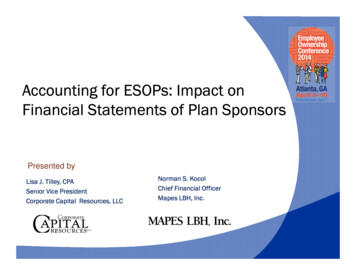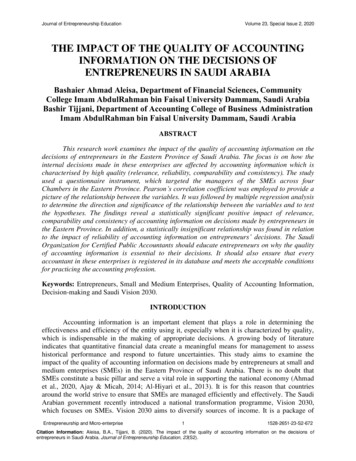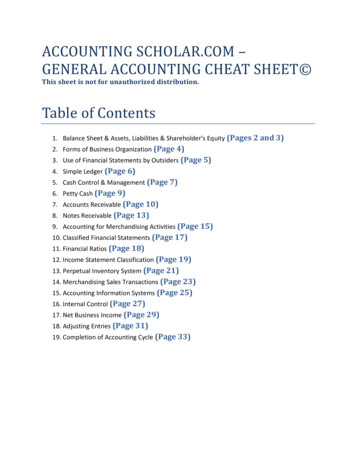
Transcription
Accounting for ESOPs: Impact onFinancial Statements of Plan SponsorsPresented byLisa J. Tilley, CPASenior Vice PresidentCorporate Capital Resources, LLCNorman S. KocolChief Financial OfficerMapes LBH, Inc.
2Goals of the Session Refresher on definitions of specific termsUnderstand how to account for ESOP transactionsReview accounting for ESOP loan paymentsReview accounting for issuance of dividends
3Citations and Resources SOP 9393-6 is no longer applicableASC 718718-40: ESOP Stock Ownership PlansNCEO publications
4Definitions and Basics Unearned or ESOP shares held in suspenseAllocated sharesDirect loanIndirect loanCompensation costContributionsDividends on CC-corporation sharesRelease of sharesShares committedcommitted-toto-be released
5Types of ESOPs NonNon-Leveraged Cash Warehouse Creeping ESOPLeveraged – Bank FinancedLeveraged – Seller FinancedLeveraged – Internally FinancedLeveraged – Blended Financing
6NonNon-Leveraged ESOPCompanyESOPESOP Contributions Company StockSellingShareholder
7Case Study 1 – NonNon-Leverage Contributions of cash or stock to an ESOP arereported as compensation expense equal to the fairvalue of the contribution.For stock contributions, the stock is valued effectiveas of the date of transfer.
8Illustration Cash Contributions – The Company contributes cashto the ESOP. The Company issues fresh shares ofcorporate stock to the ESOP in exchange for cash. Stock Contributions – The Company issues stockdirectly to the ESOP. Dilutive
9Journal EntriesTransaction – Cash ContributionDR Compensation expense 200,000CR Cash 200,000DR CashCR Common stock (par value 5CR Additional paidpaid-in capital 50,000 150,000 200,000
10Journal EntriesTransaction – Stock ContributionDR Compensation expense 200,000CR Common stock (par value 5)CR Additional paidpaid-in capital 50,000 150,000
11Tax Impact Tax deduction of 200,000No book/tax timing differences
12Key Ideas The book expense will equal the tax deduction.If the ESOP acquires stock from the shareholder withcash, it will be outside the Company’s books becausethere is no debt.There are no suspended shares; all shares areallocated to participants.
13Case Study 2 – Leveraged – Bank The Company obtains a loan from a bank.The Company lends the funds to the ESOP.The ESOP pays the selling shareholder(s) in exchangefor stock.
ESOP Case 2; Bank Financed LeveragedPurchase “Non“Non-Mirror Loans”NoteBank Loan“OutsideLoan” NoteESOPCompanyESOP Loan“Inside Loan” Company StockSellingShareholder14
15Bank Relations Post Deal:Impaired Balance Sheet They should be brought in early.Clear communication on issues that must beaddressed when calculating bank covenants andratios. Non cash charge to operations ESOP compensation needs to be an add back to EBITDA If you have a pricing matrix on lending, make sure anythingbased on EBITDA, that the ESOP compensation expense isan add back to EBITDA calculation. Communicate an understanding with the bank thatthe compensation expense trajectory will beconsidered in the valuation and repurchase liabilityestimates.
16Illustration Company borrows 900,000 from a bank for 5.5%for 7 years.ESOP borrows 1,280,000 from the Company for4.0% for 10 years consisting of the proceeds fromthe bank loan and 380,000 from existing cash.The ESOP purchases 100,000 shares from the Seller.Appraised value of stock is:Transaction Date 12.80 per shareYear 1 14.00 per shareYear 2 16.00 per share
17Case Study 2 Journal EntriesFunding and TransactionDR CashCR Note payable, bankDR Unearned ESOP shares( 12.80/sh. x 100,000 sh.)CR Cash 900,000 900,000 1,280,000 1,280,000
18Case 2 Journal EntriesBank “Outside” Loan PaymentDR Note payable, bankDR Interest expenseCR Cash 108,000 49,500 158,368
19Journal Entries“Inside” Loan Financial Statement ImpactManagement is responsible for corporate GAAP financial statementsincluding any estimates that are made. As contributions are made to theplan to pay down ESOP debt, shares are released at “fair market value”triggering the booking of compensation expense.This presents a circular problem as the appraiser wants the financialstatements before determining FMV. Management must estimate FMVbased on prior appraisal methodology incorporating current financialperformance and other pertinent factors. The estimate could besubstantial.Management must be well versed in the methodology the appraiser usesto run cash flow models etc. to estimate FMV.
20Journal Entries“Inside” Loan Financial Statement ImpactCorporate auditors will test the estimate of value and may presentadjusting entries.Significant changes could produce an adjustment which can be a largeunbudgeted expense and cause a default in a bank covenant .Significant waivers in budget versus actual will cause the appraiser topause and judge negatively if management is also presenting financialforecasts that are relied on in the appraisal process.
21Journal Entries“Inside” LoanAfter the Company makes a contribution to the ESOP in the amount of 157,000 the ESOP makes a debt service payment to the Company inthe amount of 157,812 consisting of 106,612 in principal and 51,200 in interest. As a result, 8,300 shares are released from thesuspense account for allocation to participants. The compensationexpense is based on an estimate of fair market value of shares released:DR Compensation expense(Avg. FMV 13.40/sh. x 8,300 sh.)CR Additional paidpaid-in capital( 0.60/sh. x 8,300 sh.)CR Unearned ESOP shares(Cost 12.80/sh. x 8,300 sh.) 111,220 4,980 106,240
22Key Ideas Unearned shares are a contracontra-equity account.For GAAP purposes, the interest income from the“inside loan” is not recognized.Compensation expense is based on an estimate ofthe fair value of the stock being released.How can you determine the FMV and book the entryfor release prior to the financial statements beingfinal and the appraisal being completed?
23Case Study 22-Dividends A Dividend to a CC-corporation ESOP is tax deductibleas long as the dividend is used to either service theESOP debt or it is passed through to the participants.Dividend rate must be reasonable.An SS-corporation distribution of earnings/dividend isnot deductible.
24Dividend Illustration – Year 1 At the end of Year 1, the Company issues a dividend thatwill be used to pay down debt. The dividend is 0.45 pershare (for a total of 45,000 0.45 x 100,000 shares)and the debt repayment releases 3,515 shares.The Company writes a check to the ESOP for 45,000 andthe ESOP writes a check to the Company for 45,000.
25Case 2 Dividend Journal EntryDR Compensation expense(Avg. FMV 13.40/sh. x 3,515 sh.) 47,101CR Additional paidpaid-in capital( 0.60/sh. x 3,515 sh.)CR ESOP unearned shares(Cost 12.80/sh. x 3,515 sh.) 2,096 45,005
26Tax ImpactTax Deduction Cash contribution of 157,000 plus Dividend used for debt repayment of 45,000
27Dividends to Allocated and Unearned Shares Dividends to allocated shares are charged toretained earnings.Dividends to unearned shares are charged tocompensation expense.
28Dividend Illustration – Year 2 At the end of Year 2, the Company issues a dividend thatwill be used to pay down debt. The dividend is 0.45 pershare (for a total of 45,000 0.45 x 100,000 shares)and the debt repayment releases 3,515 shares.The Company writes a check to the ESOP for 45,000 andthe ESOP writes a check to the Company for 45,000.
29Unearned SharesIn Year 2, the dividend is allocated between allocated andunearned shares. According to the thirdthird-party administrator,83% of the shares are unearned:DR Compensation expense(Avg. FMV 15/sh. x 83% x 3,515 sh.) 43,762CR Additional paidpaid-in capital( 2.20/sh. x 83% x 3,515 sh.) 6,419CR ESOP unearned shares(Cost 12.80/sh. x 83% x 3,515 sh.) 37,343
30Allocated SharesIn Year 2, the dividend is allocated between allocated andunearned shares. According to the thirdthird-party administrator,17% of the shares are unearned:DR Retained Earnings(Avg. FMV 15/sh. x 17% x 3,515 sh.) 8,963CR Additional paidpaid-in capital( 2.20/sh. x 17% x 3,515 sh.)CR ESOP unearned shares(Cost 12.80/sh. x 17% x 3,515 sh.) 1,314 7,649
31Key Ideas In a CC-Corporation, dividends on unearned shares arecompensation expense at the estimated fair value.Dividends on allocated shares are dividends.
32Case Study 3 – Leverage – Seller Note The Seller takes back a note from the ESOP inexchange for stock.
33Case Study 3 – Leverage – Seller NoteCompanyESOPESOP Contributions Note Company StockSellingShareholder
34Illustration – Seller Financed Note Company purchases 100,000 shares from Seller for 1,000,000.Seller receives a note for 1,000,000 at 5.0% for 15years.Appraised value of stock is:Transaction Date 10.00 per shareYear 1 10.50 per shareYear 2 11.00 per share
35Journal Entries - TransactionDR ESOP unearned shares 1,000,000CR Note payable, seller 1,000,000
36Journal Entries - RepaymentDR Interest expenseDR Note payable, sellerCR CashDR Compensation expense(Avg. FMV 10.25/sh. x 6,667 sh.)CR Additional paidpaid-in capital( 0.25/sh. x 6,667 sh.)CR ESOP unearned shares(Cost 10/sh. x 6,667 sh.) 50,000 46,342 96,342 68,337 1,667 66,670
37Financial Footnotes Significant Accounting Policies External (direct loan) versus Internal (indirect) ESOP DebtFASB ASC 718 Recognition of compensation costs Employee Stock Ownership Plan Details of plan History of stock purchases Current contributions Current released and unreleased shares Estimated current FMV of shares Schedule of future share releases
38Key Takeaways Accounting for ESOPs is not rocket science nor is it intuitiveUnearned ESOP shares are a contracontra-equity accountStock is released from suspense and allocated to planparticipants as debt is paid downCompensation costs are measured by the fair value of theshares releasedInterest income from “inside” loan is not reported
39Disclosure This presentation is designed to provide accurateand authoritative information in regard to the subjectmatter covered. This information is provided solelyas a teaching tool, with the understanding that theinstructors are not engaged in rendering legal,accounting or other professional opinions and thatthey are not offering advice in this presentation andthese accompanying materials.
40Accounting for ESOPsQuestions?Lisa J. Tilley, CPASenior Vice PresidentCorporate Capital Resources, LLCNorman S. KocolChief Financial OfficerMapes LBH, Inc.
Illustration Company borrows 900,000 from a bank for 5.5% for 7 years. ESOP borrows 1,280,000 from the Company for 4.0% for 10 years consisting of the proceeds from the bank loan and 380,000 from existing cash. The ESOP purchases 100,000 shares from the Seller. Apprais











